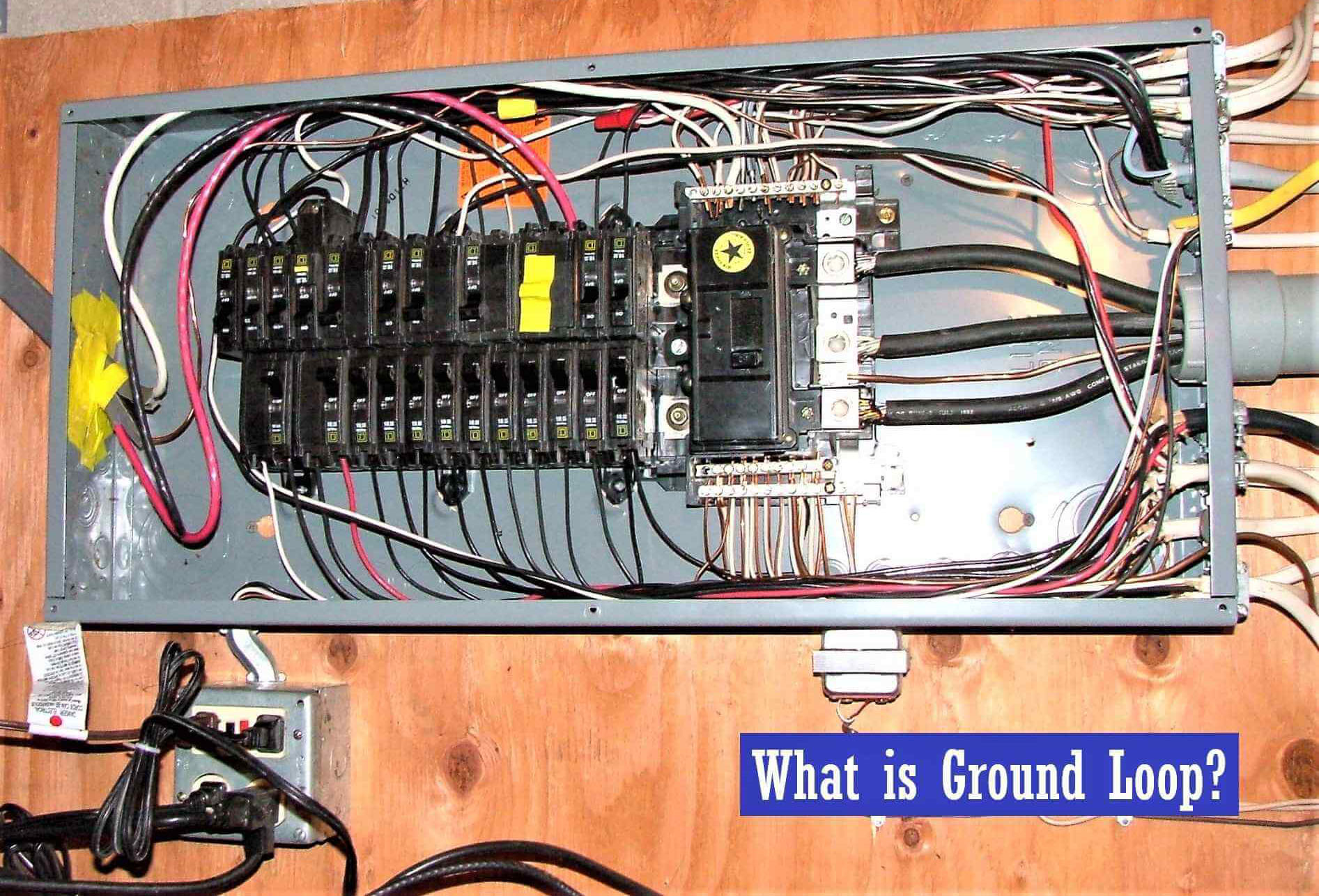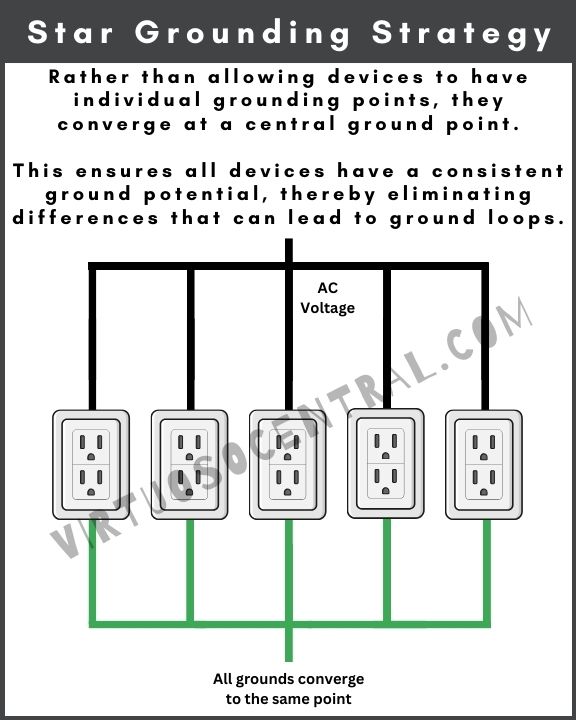Have A Tips About How Do You Troubleshoot A Ground Loop

Understanding Ground Loops
1. What Exactly is a Ground Loop Anyway?
Ever heard an annoying hum or buzz coming from your audio equipment, even when nothing's playing? Chances are, you've encountered the dreaded ground loop. It's like that uninvited guest at a party who just won't leave, but instead of eating all your snacks, it messes with your sound. Ground loops happen when there are multiple paths to ground in your audio system, creating a difference in electrical potential. This difference causes a current to flow through the ground wires, which then gets picked up as noise in your audio signal. Think of it as a tiny, unwanted electrical roundabout.
Ground loops are particularly common in setups with multiple interconnected devices, such as home theaters, recording studios, or even car audio systems. Each piece of equipment is grounded, usually through its power cord. When these grounds aren't perfectly aligned in potential, a small current starts circulating — and thats where the trouble begins. Its less of a serious electrical hazard and more of an annoyance that can drastically affect the quality of your audio experience. Imagine listening to your favorite song, only to have it constantly battling with a persistent buzzing sound; not exactly ideal, is it?
So, why is this happening? Well, electrical outlets and devices aren't always perfectly grounded. Small voltage differences can exist between different ground points. When you connect several devices together, each with its own ground connection, these small differences create a loop. This loop acts like an antenna, picking up electromagnetic interference (EMI) and adding it to your audio signal. It's like your audio signal is trying to have a conversation, but EMI is constantly interrupting with annoying interjections. Nobody wants that!
The trick is to break that loop, ensuring all your audio equipment shares a common ground reference. It's like getting everyone on the same page so they can understand each other clearly. Doing so can involve a few different techniques, which we'll dive into shortly. Before we get too deep into the solutions, let's briefly touch on identifying if you indeed have a ground loop. The telltale sign is usually a low-frequency hum, often at 50 or 60 Hz (depending on your region's electrical frequency), that doesn't change with the volume setting. If that sounds familiar, keep reading!

How To Solve Electrical Ground Loop Problems?
Pinpointing the Source
2. Isolating the Culprit
Alright, you suspect you have a ground loop. Now comes the fun part — detective work! The goal here is to systematically isolate each component in your system to identify which device is causing the loop. Think of it like tracing a tangled string back to its origin. Start by disconnecting all your audio cables (RCA, XLR, etc.) between devices, leaving only the power cables connected. Then, one by one, reconnect each audio cable, listening carefully after each connection for the return of the hum.
When the hum reappears, you've likely found the connection that's introducing the ground loop. But hold on, it's not always that straightforward! Sometimes, the problem isn't a single device, but a combination of devices interacting. If disconnecting individual components doesn't completely eliminate the hum, try disconnecting them in different combinations. For instance, if you have a mixer connected to an amplifier and a computer, try disconnecting the computer first, then the amplifier, and so on. It's like trying different puzzle pieces to see which combination fits.
Another handy trick is to use a ground loop isolator. This device electrically isolates the audio signal, breaking the ground loop path. You can insert it between two devices you suspect are causing the problem. If the hum disappears, you've confirmed that the ground loop was indeed the issue. Ground loop isolators are relatively inexpensive and can be a lifesaver in complex setups. Just be aware that some cheaper isolators might slightly degrade the audio quality, so it's worth investing in a decent one.
Don't overlook the obvious either. Sometimes, a loose or faulty ground connection can cause similar issues. Check all your power cords and outlets to ensure they're properly grounded. A simple outlet tester can be a valuable tool here. If you find any outlets with reversed polarity or missing grounds, have them fixed by a qualified electrician. After all, prevention is better than cure, right?

5 Ways To Eliminate Ground Loops Part 1 Interference Technology
Breaking the Loop
3. Effective Techniques for Eliminating Ground Loops
Okay, you've identified the source of the hum. Now, let's get rid of it! There are several effective techniques you can use to break the ground loop and restore clean, noise-free audio. One of the most common and straightforward solutions is to use a ground lift adapter. These adapters disconnect the ground pin on the power cord, effectively breaking the ground loop path. However, it's important to use these adapters with caution, as they can potentially increase the risk of electrical shock. They should only be used as a last resort, and only on equipment that doesn't require a safety ground (check the device's manual).
A safer and often more effective approach is to use a balanced audio connection. Balanced connections use three wires — one for the positive signal, one for the negative signal, and one for the ground. The noise picked up on the signal wires is canceled out at the receiving end, effectively eliminating the ground loop hum. XLR cables are a common type of balanced connection, often used in professional audio equipment. If your equipment supports balanced connections, switching from unbalanced (RCA) to balanced (XLR) can often solve the problem. It's like sending your audio signal through a filter that removes all the unwanted noise.
Another effective solution is to use a ground loop isolator, as mentioned earlier. These devices use transformers to electrically isolate the audio signal while maintaining the ground connection for safety. They're available in various forms, including RCA, XLR, and even headphone versions. When selecting a ground loop isolator, make sure to choose one that's designed for audio applications and has a high-quality transformer to minimize any potential signal degradation. A good isolator will remove the hum without noticeably affecting the sound quality. Think of it as a specialized filter that targets only the ground loop noise.
In some cases, the ground loop may be caused by a faulty or poorly shielded cable. Try replacing your audio cables with high-quality, shielded cables. Shielded cables help to block electromagnetic interference (EMI) from entering the signal path, reducing the likelihood of ground loop problems. It's like wrapping your audio signal in a protective layer that shields it from external noise. A simple cable upgrade can sometimes make a significant difference in reducing or eliminating ground loop hum.

The Star Grounding Method
4. Centralized Grounding for Optimal Performance
For more complex audio setups, especially in recording studios or home theaters, the star grounding method can be a highly effective way to prevent ground loops. The basic principle is to create a single, central grounding point for all your equipment. This point is typically connected to the building's main ground. All devices are then grounded back to this central point, creating a star-like configuration. This ensures that all devices share a common ground reference, minimizing the potential for voltage differences and ground loop currents.
Implementing star grounding can involve a bit of planning and rewiring, but the results are often worth the effort. You'll need a dedicated grounding bar or busbar, which is a conductive strip that serves as the central grounding point. Connect all your equipment's ground wires to this busbar, ensuring that each connection is secure and reliable. Use heavy-gauge wire for the ground connections to minimize resistance and ensure a low-impedance path to ground. It's like creating a central hub for all your grounding needs, ensuring everyone is on the same page.
When setting up a star grounding system, it's crucial to isolate the grounding point from any potential sources of noise or interference. Avoid running ground wires alongside power cables or other sources of EMI. Keep the ground wires as short as possible to minimize inductance. It's like creating a clean and isolated environment for your grounding system, ensuring that it's free from any external noise sources.
Star grounding isn't just for professional studios; it can also be beneficial for home audio systems. If you're experiencing persistent ground loop problems that you can't solve with other methods, consider implementing a simplified star grounding system. Even a basic star grounding setup can significantly reduce ground loop hum and improve the overall audio quality of your system. Think of it as a long-term investment in your audio experience, ensuring clean and noise-free sound for years to come.

Understanding & Solving Ground Loops
FAQ
5. Your Questions Answered
Let's tackle some frequently asked questions about ground loops, ensuring you have a comprehensive understanding of this common audio issue.
Q: Will a power conditioner solve my ground loop problem?A: Not always. While power conditioners can filter out noise and protect your equipment from voltage surges, they don't necessarily break ground loops. Some high-end power conditioners may include ground isolation features, but it's essential to check the specifications before assuming it will solve your ground loop issue. A power conditioner is more about cleaning the power coming in, not fixing grounding issues between devices.
Q: Can a DI box help with ground loops?A: Yes, absolutely! A DI (Direct Injection) box is specifically designed to convert unbalanced signals to balanced signals, which, as we discussed, is a great way to break ground loops. DI boxes often include a ground lift switch, which further isolates the ground connection. They're commonly used in live sound and recording scenarios to eliminate ground loop hum when connecting instruments directly to a mixer or interface. A DI box is like a translator, converting your signal into a format that's less susceptible to ground loops.
Q: Is it safe to cut the ground pin on a power cord?A: Generally, no. Cutting the ground pin is highly discouraged, as it removes the safety ground provided by the power cord. This can increase the risk of electrical shock, especially in equipment that relies on a safety ground. It's always better to use alternative solutions, such as balanced connections or ground loop isolators, to eliminate ground loops. Think of the ground pin as a vital safety feature; removing it is like removing the brakes on your car — not a good idea!
Q: My ground loop hum only appears when my computer is connected. What should I do?A: Computers are often a common source of ground loops due to their complex internal circuitry and multiple grounding points. Try using a USB isolator or an audio interface with built-in ground isolation. You can also try plugging your computer and audio equipment into the same power outlet or power strip to minimize potential ground differences. If your computer has a metal chassis, ensure it's not touching any other grounded equipment. Sometimes even a small physical contact can cause a ground loop.
